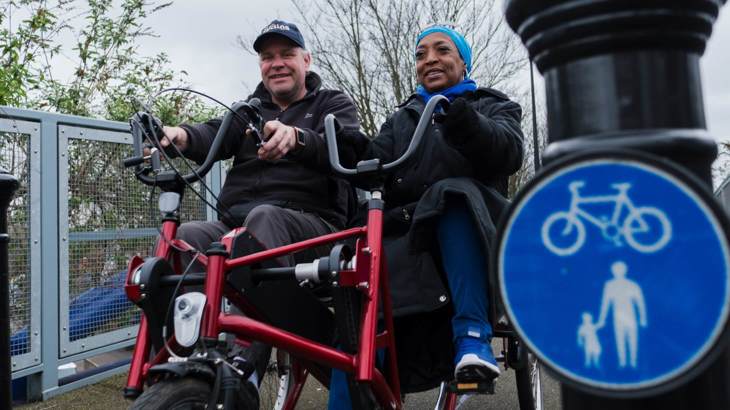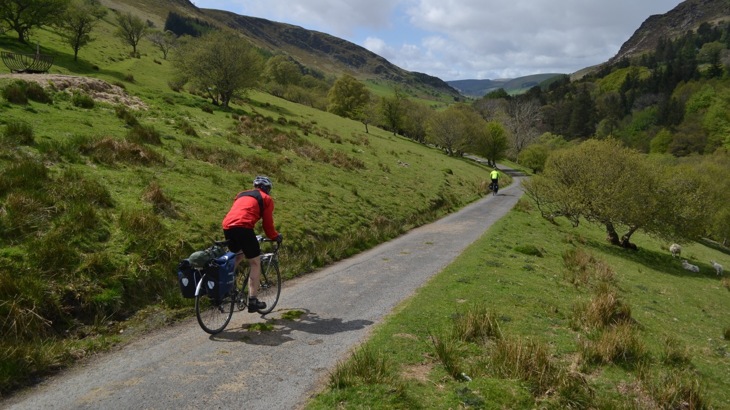Reclassification of the National Cycle Network FAQs
We’re making changes to the National Cycle Network to make it more accessible and to provide a consistent user experience for everyone.
These FAQs explain the changes to our online mapping, our website and the way we promote the Network, to help you plan your everyday journeys and leisure trips.
What do the dashed lines on the OS map mean?
The dashed lines show on-road and traffic-free routes that are not part of the National Cycle Network.
Many of these on-road sections were formerly part of the Network, and have now been reclassified due to high motor traffic speeds and volumes.
These sections do not meet the high quality standards we aspire to for the Network. However, they form part of valued named routes, so we still promote them to experienced users.
Why have some sections of route completely disappeared from the map?
Where the on-road sections we’ve identified in this process do not form part of well-loved named routes, or are on roads where motor traffic is simply too busy and fast, we have removed them from the online mapping.
In some cases we have also removed sections because they duplicated other sections, they were left isolated by nearby removals, or they added little value to the Network.
How can I find out if my local route has been affected?
The best place to look is on the Network layer of the online OS Map. You can search by location and use the key to find out whether your local route has been affected by reclassification. Reclassified sections will appear with a dashed line.
Is there a list of routes or sections that have been removed?
We have not published a list of removed route sections. However, removed route sections will no longer be visible on the OS map.

The Sustrans website now shows routes which you say are not wholly on the Network and are recommended for more experienced cyclists. What level of experience do I need to ride these routes?
These routes contain or are made up entirely of reclassified route sections. This means they are on roads that are likely to be too fast or busy for beginners and families.
We recommend these routes to users who are confident cycling in traffic and meet Bikeability Level 3 criteria.
If a route is no longer in the National Cycle Network section of your site, does that mean it has been completely removed from the Network?
We have organised the route descriptions on our website into two lists – one for routes that are completely on the National Cycle Network, and another for routes which contain reclassified sections. The routes in the first list show a little red sign icon to indicate that they run entirely on the Network.
The routes in this second list may run fully or only partially on reclassified route sections. The best way to see how much of the route runs on fast and busy roads is by consulting the OS online mapping.
How will you amend signage for removed and reclassified route sections?
We will be removing the red National Cycle Network number patch signs on removed sections of the Network.
We will also remove the red National Cycle Network number patch on reclassified sections. However, the branded signage or logo for the named route that the section runs on will be retained.
For example, the named route the Caledonia Way will be signed for the entirety of its length with the Caledonia Way logo. However, the National Cycle Network number patch will be taken down on reclassified sections. On sections that remain part of National Cycle Network Route 78, there will be both the Caledonia Way logo and the red Network number patch.
Similarly, where a section of the named C2C route has been reclassified, the red Network number patch will be removed, but the C2C logo will remain. On the sections that are both on the Network and on the C2C, a C2C logo and red number patch will still be present.
Will the routes you are removing and reclassifying no longer be signed on the ground?
Changes will be made to the signs but this will be a gradual process. For now, removed and reclassified route sections will still be signed with the red National Cycle Network number patch.
Over the next year we will be working with our volunteers and partners to amend signage on the ground. We will prioritise sections that have been removed as these are no longer visible on our online map.
We hope to have updated signage on both removed and reclassified sections by summer 2021.

I’ve just bought a paper map from your shop – is that now out of date?
Our printed maps will take some time to amend. So, the current stock of maps in our shop will not mark out reclassified sections from the National Cycle Network, and will also still show removed sections as being on the Network.
You will of course still be able to ride these routes but it is worth noting that some on-road sections may have higher traffic speed and volume than others, and these are shown with a dashed line in the online OS map.
We are currently planning to amend our printed maps as our stock depletes, and will prioritise the products which require the most changes.
I had planned to do a long-distance bike tour on a route that now contains reclassified sections. Can I still do it?
The on-road sections of these routes will still be there for anyone to ride, though we recommend that they should be used by those with confidence and experience of riding on roads.
My local traffic-free route on the Network is really poor. Why hasn’t that been dealt with in this process?
Our aim is to create a traffic-free Network that is fully accessible and suitable for everyone to enjoy, and this includes families, disabled people and those using mobility cycles.
The changes we are making by removing or reclassifying routes is a major step towards achieving this.
As a priority, we have dealt with on-road sections where the amount and speed of motor traffic is prohibitive to some user groups, such as families and people who are new to cycling.
However, we are also working hard on other improvement projects with 80 underway and more in the pipeline.
These include improvements to traffic-free routes, such as removing barriers, upgrading surfaces, creating safer crossings of roads and creating new traffic-free route sections. Find out more about our work in progress on the Network.
Will any of the removed or reclassified sections be replaced with traffic-free paths?
We are planning for an improved Network that connects towns, cities and communities, and the number of traffic-free miles on the Network will grow in the medium term as we create new paths. Our Network teams are working hard to deliver 80 improvement projects across the UK, with more in the pipeline.


